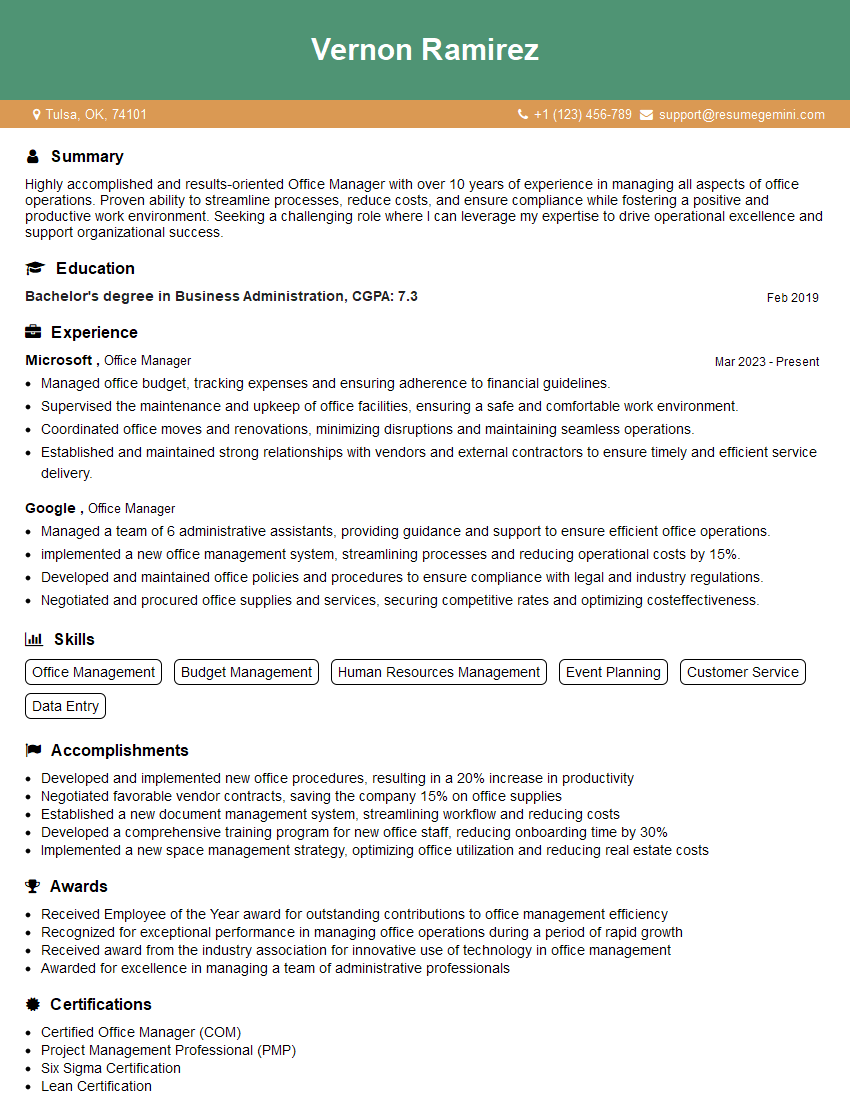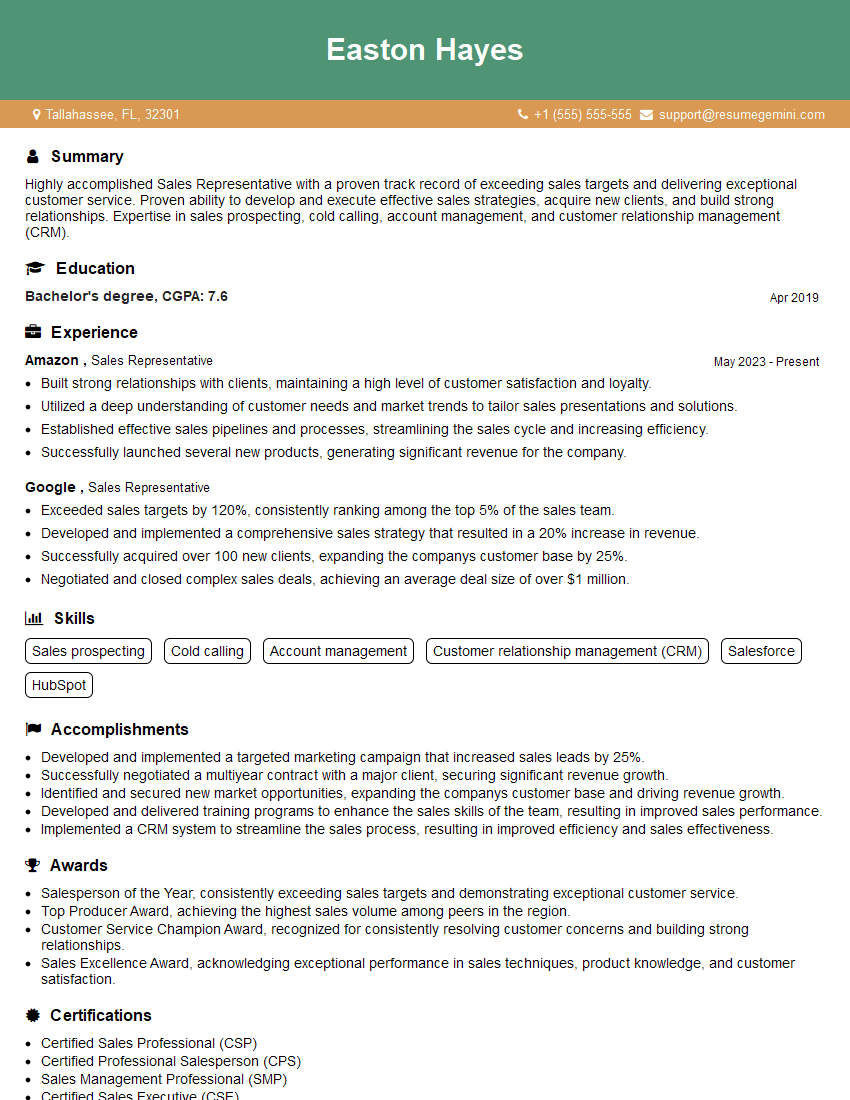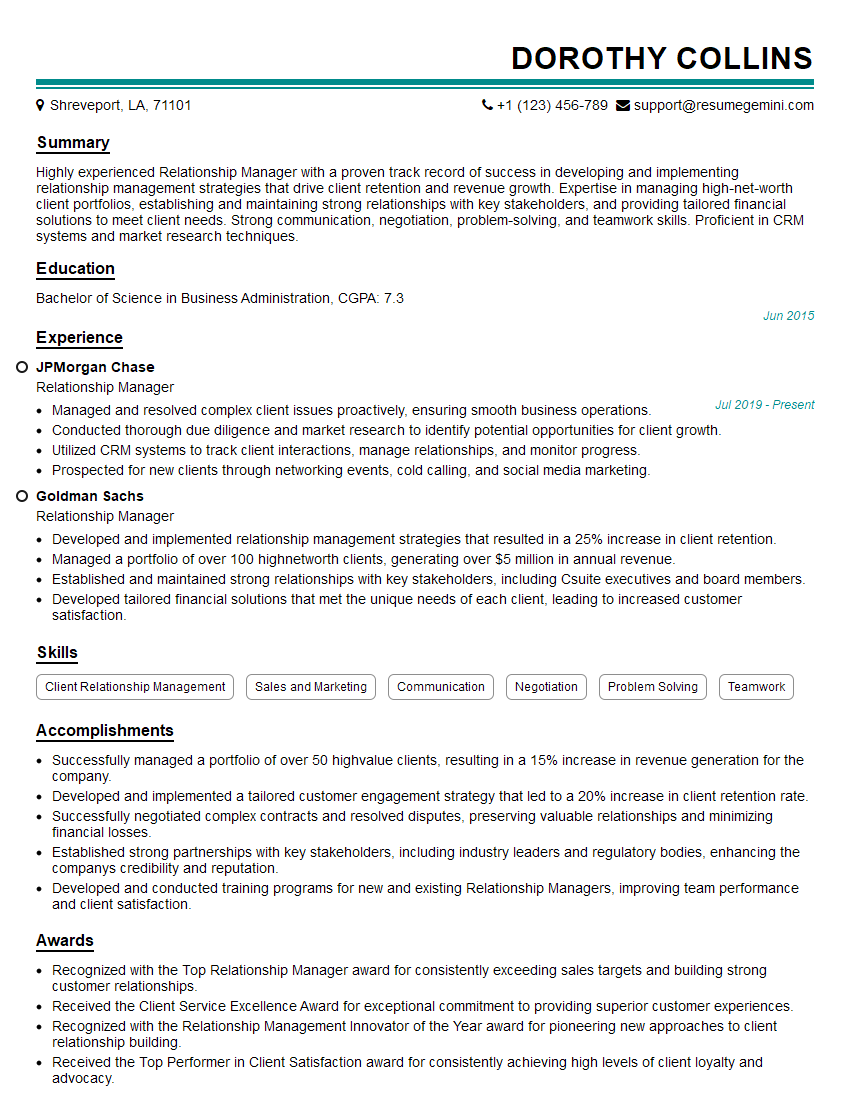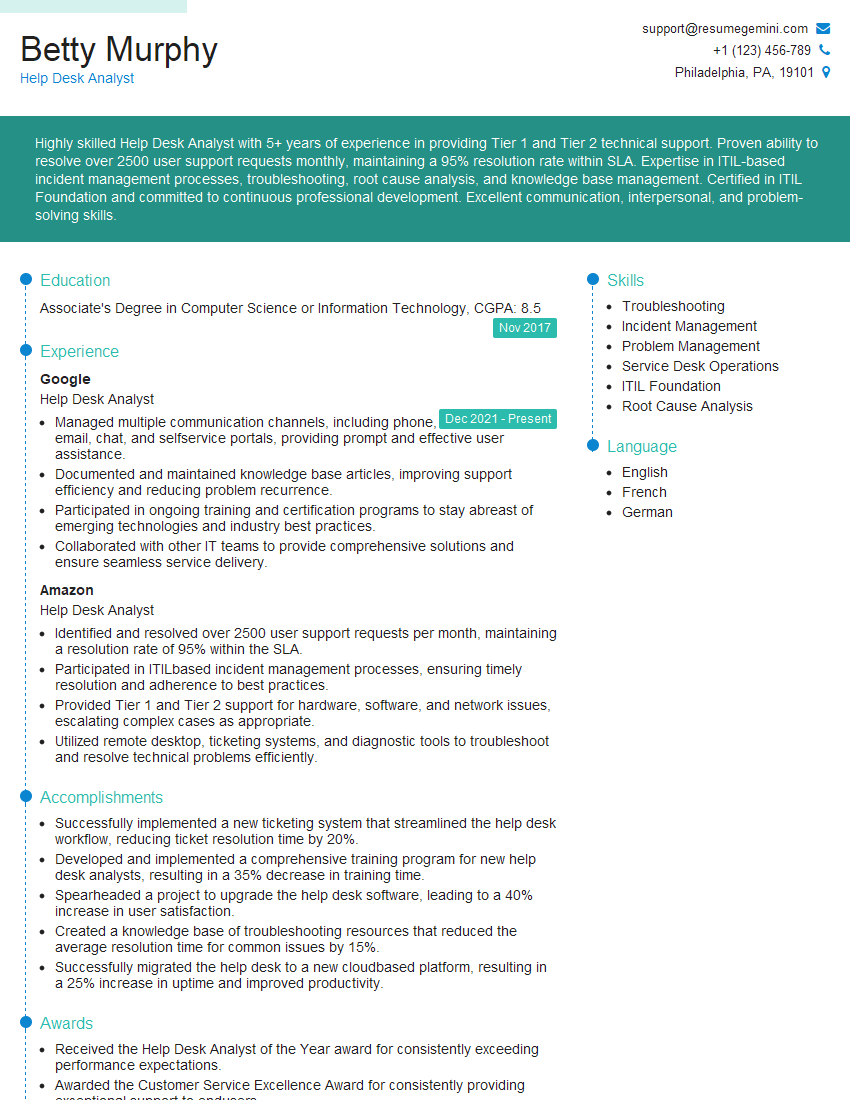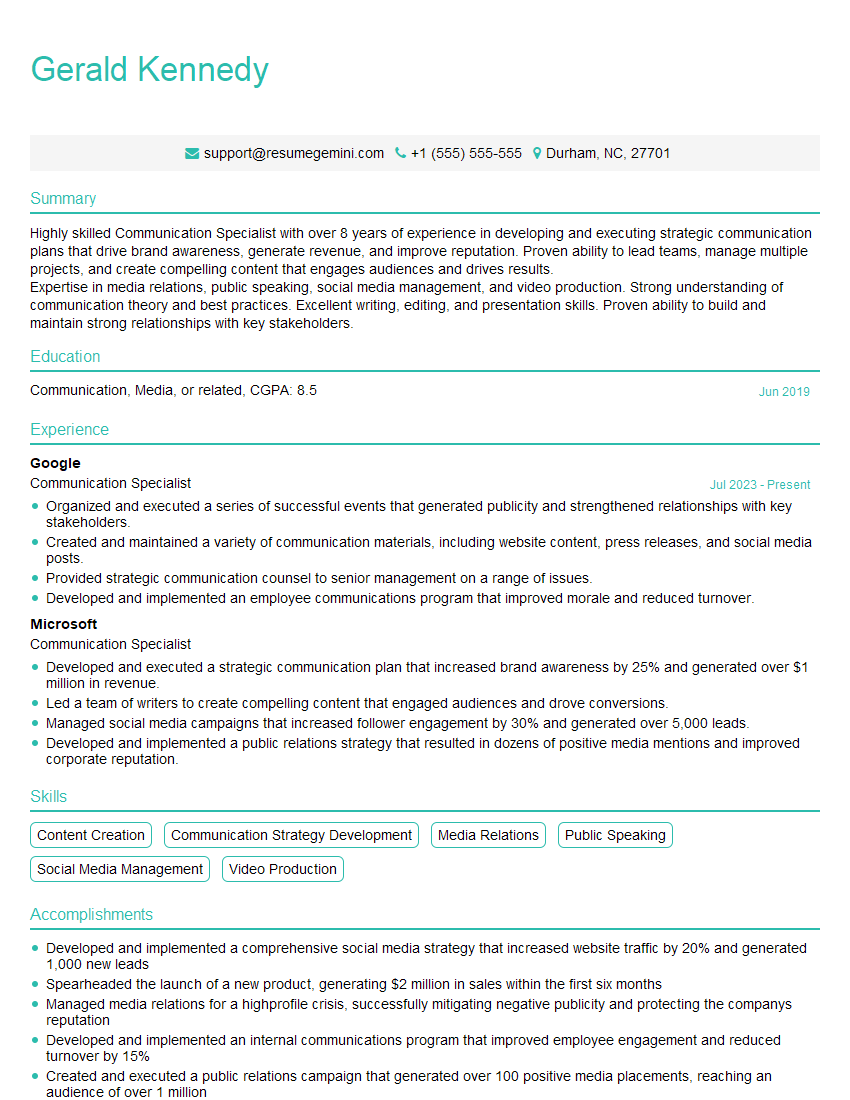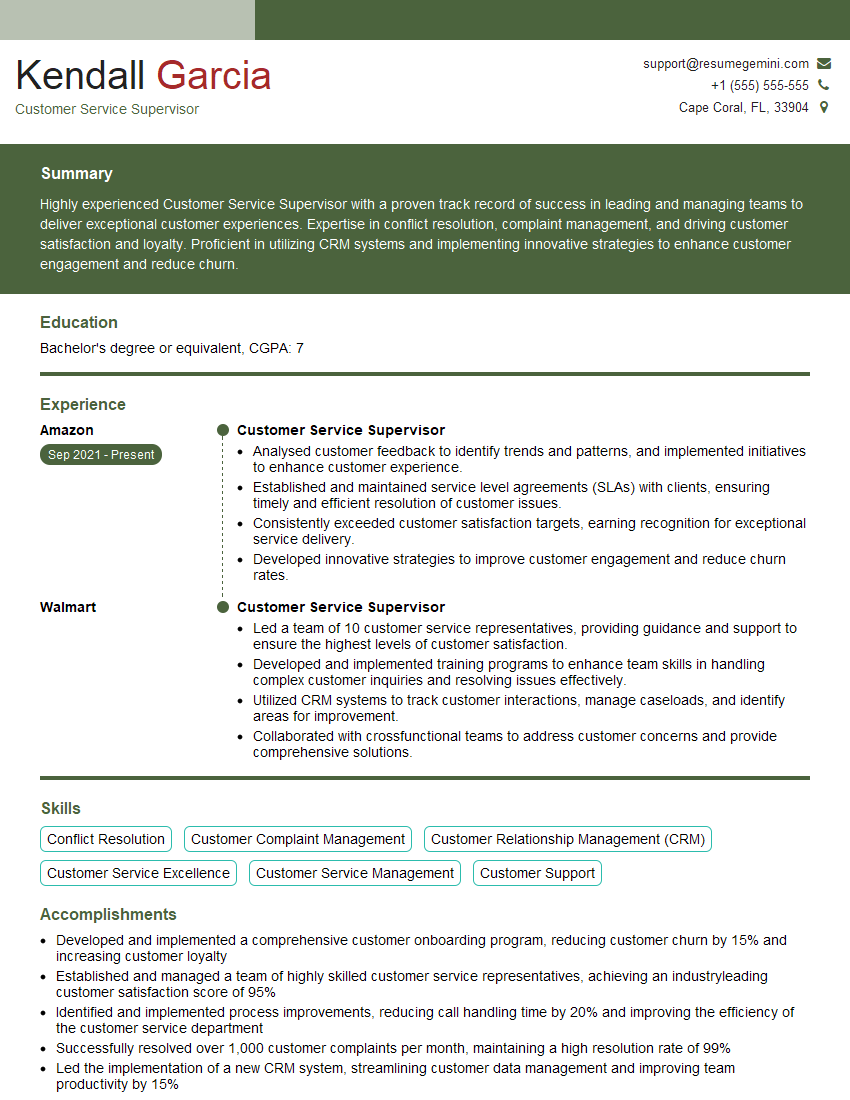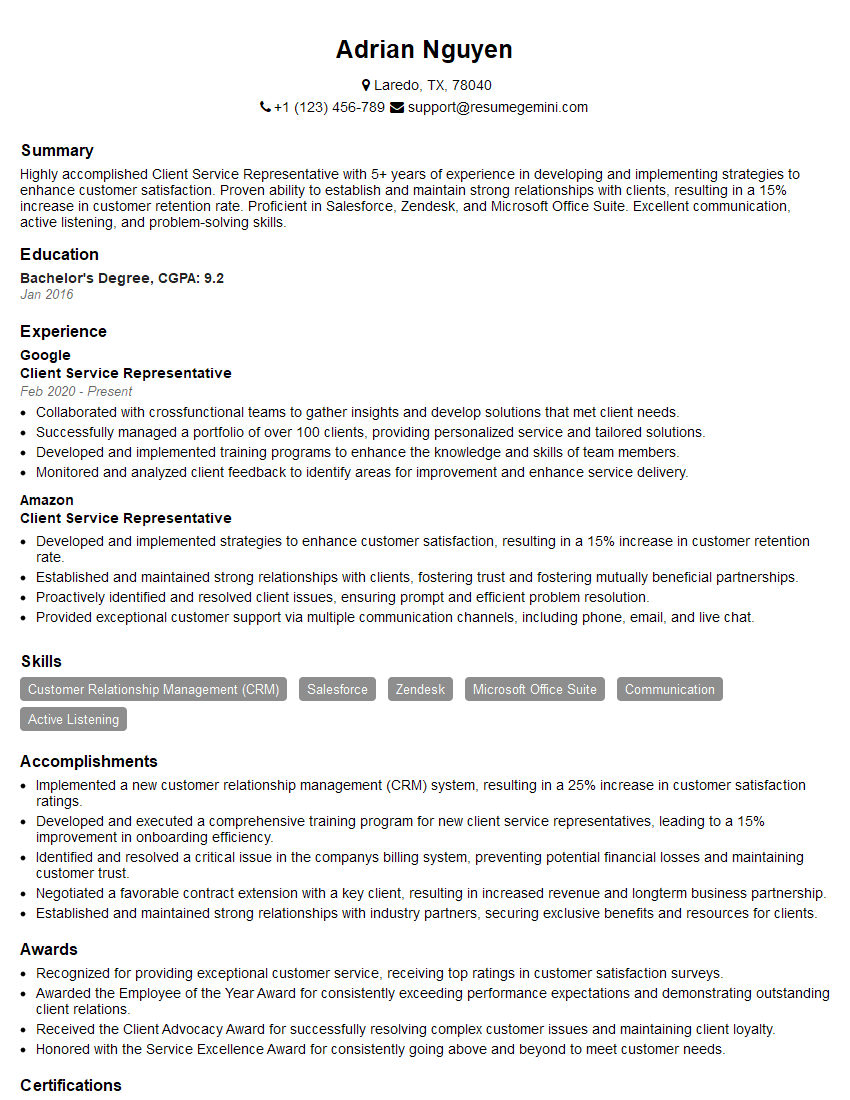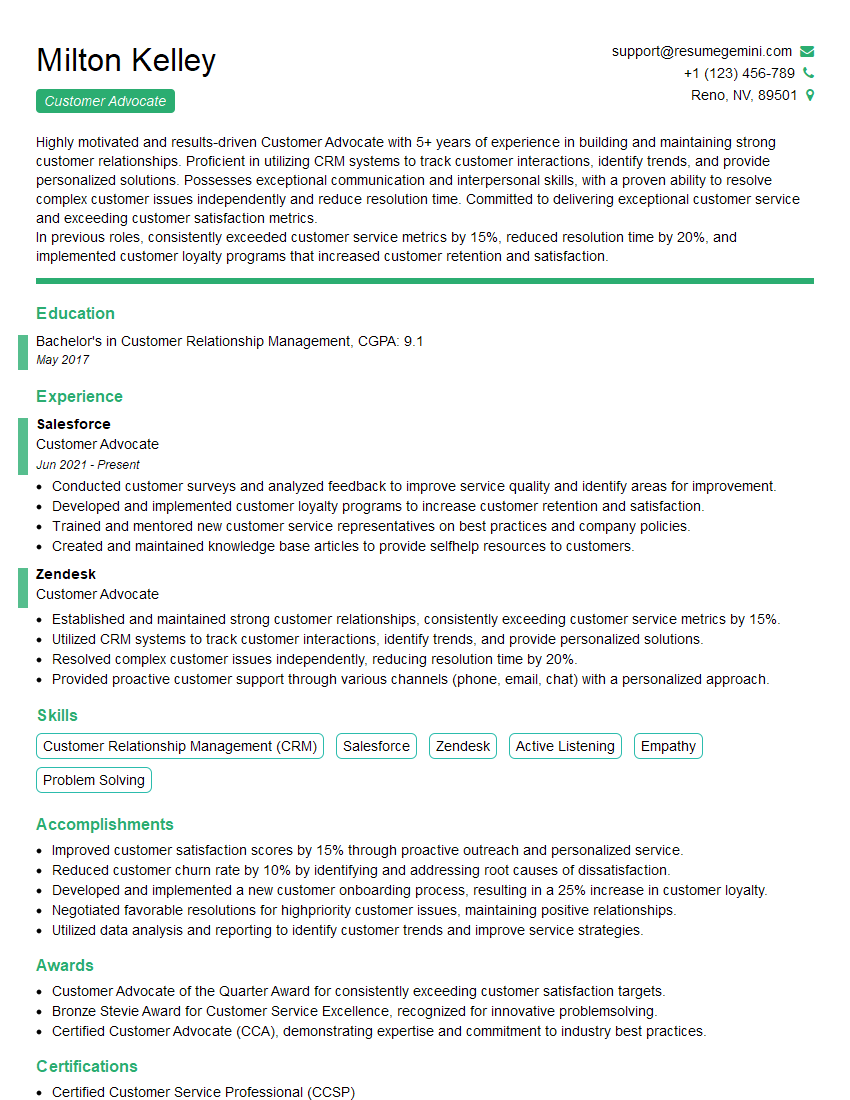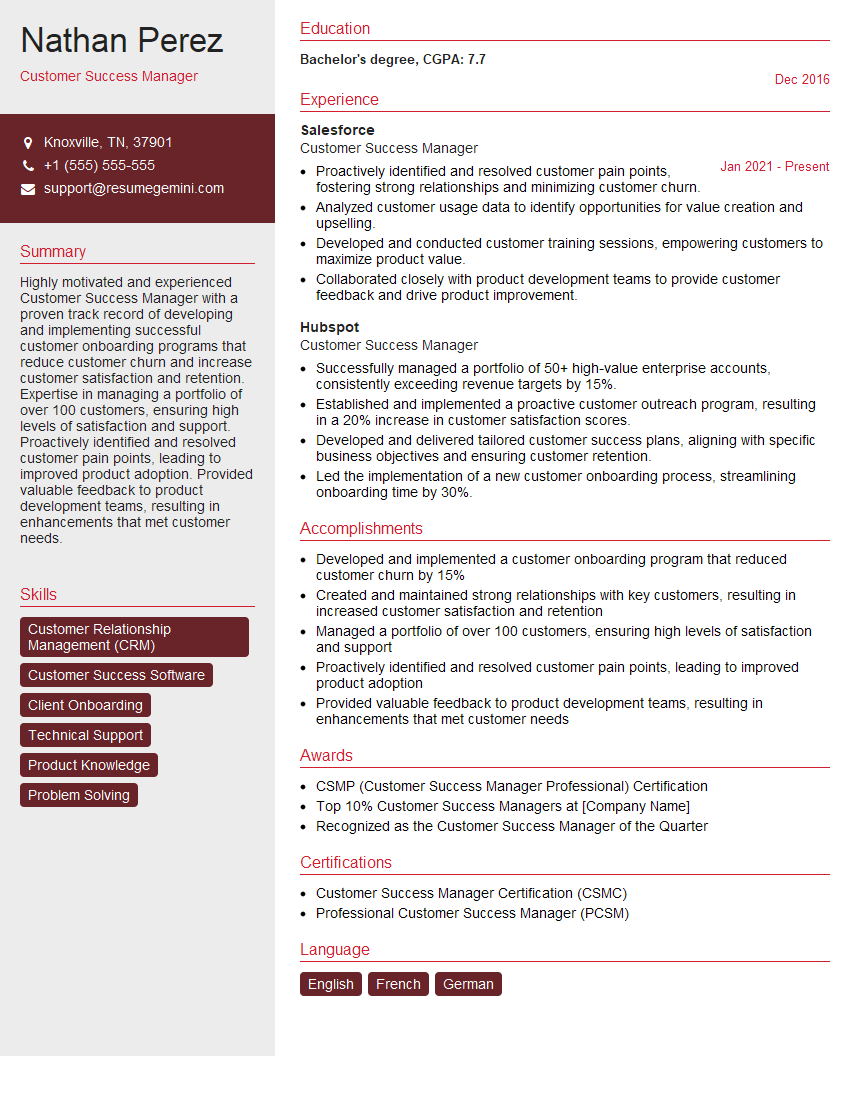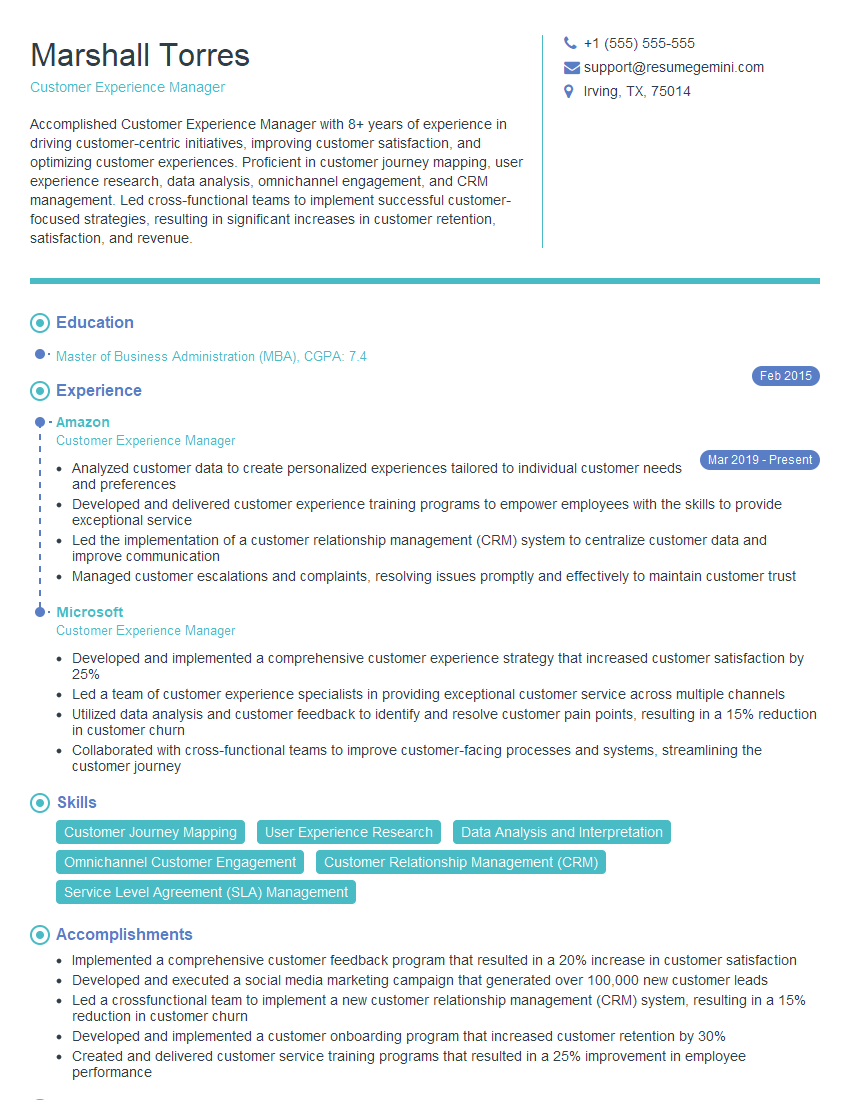Unlock your full potential by mastering the most common Experience in customer service and communication interview questions. This blog offers a deep dive into the critical topics, ensuring you’re not only prepared to answer but to excel. With these insights, you’ll approach your interview with clarity and confidence.
Questions Asked in Experience in customer service and communication Interview
Q 1. Describe your experience handling difficult customer interactions.
Handling difficult customer interactions requires a calm, empathetic, and solution-oriented approach. It’s about understanding the customer’s perspective, validating their feelings, and working collaboratively towards a resolution. I approach these situations by actively listening, showing genuine concern, and remaining professional, even under pressure.
For example, I once dealt with a customer who was extremely frustrated due to a prolonged shipping delay. Instead of getting defensive, I acknowledged their frustration, apologized for the inconvenience, and proactively offered solutions, such as expedited shipping or a partial refund. I kept them updated throughout the process and ensured clear communication every step of the way. This proactive and empathetic approach transformed their negative experience into a more positive one.
Another strategy I employ is to find common ground. By focusing on shared goals, such as resolving the issue efficiently, I can build rapport and de-escalate tension. A structured approach – asking clarifying questions, summarizing their concerns, and outlining steps for a solution – helps maintain control and keeps the conversation productive.
Q 2. How do you prioritize competing customer requests?
Prioritizing competing customer requests necessitates a well-defined system that balances urgency, impact, and customer importance. I utilize a combination of factors, including the severity of the issue, its potential impact on the business, and the customer’s relationship with the company. A helpful framework is to categorize requests using a matrix (e.g., high urgency/high impact, low urgency/low impact).
For instance, a critical system outage affecting multiple customers would naturally take precedence over a minor billing query. I also consider customer loyalty and historical interactions when determining priorities. A long-standing, high-value customer’s request might receive higher attention than a new customer’s less critical issue. Transparency is crucial; I always communicate with customers about the prioritization process, offering estimated resolution times and keeping them informed of progress.
Q 3. Explain your approach to resolving customer complaints.
My approach to resolving customer complaints follows a structured, empathetic problem-solving process. It starts with active listening and understanding the root cause of the complaint. This involves asking clarifying questions, paraphrasing to ensure understanding, and avoiding interruptions. Then, I empathize with their frustration and validate their feelings. Next, I collaboratively develop a solution, outlining options and their potential implications. Finally, I follow up to ensure satisfaction and document the resolution to prevent future occurrences.
For example, if a customer received a damaged product, I wouldn’t just offer a replacement. I would first apologize sincerely, investigate the cause of the damage (was it due to shipping or a manufacturing defect?), and offer a suitable solution, which might include a replacement, refund, or even a discount on future purchases. A written follow-up confirms the resolution and shows ongoing commitment to customer satisfaction.
Q 4. What communication methods do you find most effective?
The most effective communication methods depend on the context and the customer’s preference, but I generally favor a multi-channel approach. Email is suitable for detailed information or formal communication, while phone calls allow for immediate interaction and more nuanced conversations. Live chat is ideal for quick, easily resolved issues. I also leverage social media platforms when appropriate, demonstrating responsiveness and transparency.
For example, for a complex technical issue, I would prefer a phone call or a video conference to ensure clear communication and real-time problem-solving. For simple inquiries or updates, email or live chat might suffice. Using the appropriate channel enhances efficiency and ensures that the message is effectively conveyed and understood.
Q 5. How do you adapt your communication style to different audiences?
Adapting communication style involves considering the audience’s technical expertise, communication preferences, and cultural background. For technical audiences, I use precise, jargon-appropriate language, whereas with non-technical audiences, I use clear, concise language avoiding technical terms or explaining them simply.
For example, when speaking to a software developer, I can readily use technical terms like ‘API’ or ‘SDK’. However, when speaking to a non-technical customer, I would explain the same concepts using plain language like, ‘the system that allows our software to connect with others’ or ‘a toolkit that helps customize the software’. Similarly, I adjust my tone and pace to suit each individual’s style – formal with some and informal with others, depending on the rapport established.
Q 6. Describe a time you had to deal with an angry customer. How did you de-escalate the situation?
I once encountered an extremely angry customer whose order had been significantly delayed due to unforeseen circumstances beyond our control. My immediate response was to listen empathetically without interruption. Once they had finished venting, I acknowledged their frustration, apologized for the inconvenience, and explained the situation clearly and honestly. I avoided defensiveness, focusing instead on shared responsibility and finding a solution.
I offered a significant discount on their next order, expedited shipping for the current order, and a complimentary gift as a token of apology. I maintained a calm, reassuring tone throughout the conversation, validating their feelings and demonstrating genuine concern. This approach helped de-escalate the situation significantly, and ultimately, the customer expressed satisfaction with the resolution and understanding of the challenges we faced.
Q 7. How do you proactively identify and address customer needs?
Proactively identifying and addressing customer needs involves anticipating potential issues and offering solutions before the customer even expresses a problem. This proactive approach strengthens customer relationships and builds loyalty. It involves leveraging various data points – past purchase history, website analytics, common customer issues, and feedback mechanisms – to understand customer patterns and pain points.
For instance, if a customer frequently orders a specific product, I might proactively suggest related items or offer a discount on their next purchase of that product. Or, if website analytics show a spike in questions about a specific feature, I could create a FAQ or tutorial to address those concerns proactively. Regularly reviewing customer feedback, surveys, and social media mentions can provide additional valuable insights into potential issues and areas for improvement.
Q 8. How do you handle situations where you don’t have all the answers?
Honesty and transparency are key when facing unknowns. I never pretend to have all the answers. Instead, I acknowledge the situation, assuring the customer that I’m committed to finding a solution. My approach involves several steps:
- Acknowledge the unknown: I’ll say something like, ‘I don’t have the answer to that right now, but I’m happy to find out for you.’
- Set expectations: I’ll give a realistic timeframe for finding the answer, such as, ‘I can check with our specialist and get back to you within 30 minutes.’
- Find the answer: I’ll utilize available resources – internal databases, colleagues, online documentation – to find the solution.
- Follow up: Once I have an answer, I contact the customer promptly, even if it’s to explain that further investigation is needed.
For example, if a customer inquires about a complex technical issue I’m unfamiliar with, I’ll escalate it to our technical support team and keep the customer updated on the progress. This demonstrates proactive problem-solving and maintains a positive customer experience.
Q 9. How do you ensure clear and concise communication in written and verbal formats?
Clear and concise communication is crucial for positive customer interactions. I focus on adapting my style to the audience and context. In writing, I use bullet points, short paragraphs, and plain language to avoid ambiguity. In verbal communication, I use active listening, confirm understanding, and speak clearly and at a pace that is easy to follow.
- Written Communication: I use professional tone, proper grammar, and avoid jargon. I employ visual aids like screenshots or flowcharts where applicable to improve understanding. Emails are concise and well-structured, with a clear subject line and call to action.
- Verbal Communication: I use open-ended questions to encourage customers to elaborate and to understand their concerns completely. I paraphrase their statements to ensure comprehension. I also avoid interruptions and maintain a respectful and empathetic tone.
For instance, rather than writing, ‘The system experienced unexpected downtime,’ I would write, ‘We experienced a brief service interruption between 2 PM and 2:15 PM due to scheduled maintenance. We apologize for any inconvenience this may have caused.’ This is more customer-centric and informative.
Q 10. Describe your experience using CRM or ticketing systems.
I’m highly proficient in using CRM (Customer Relationship Management) and ticketing systems. My experience spans various platforms, including Salesforce, Zendesk, and Freshdesk. I understand the importance of accurate data entry, efficient ticket management, and leveraging system features for improved customer service.
- Data Entry: I ensure all customer interactions, including details of the issue, resolution, and follow-up actions are meticulously recorded in the CRM. Accurate data is essential for tracking trends, measuring performance, and identifying areas for improvement.
- Ticket Management: I prioritize tickets based on urgency and importance, ensuring timely resolution. I utilize features like automated responses, canned messages, and escalation protocols to manage workflow efficiently.
- System Features: I actively utilize reporting and analytics tools to track key metrics like customer satisfaction, resolution times, and first-contact resolution rates. This helps me identify areas where I can enhance my performance and contribute to overall team improvement.
In my previous role at [Previous Company Name], I utilized Salesforce to manage customer interactions. I learned to effectively leverage its features for contact management, case tracking, and reporting, resulting in a significant improvement in our team’s response times and customer satisfaction scores.
Q 11. How do you measure your success in a customer service role?
I measure my success in customer service through a combination of qualitative and quantitative metrics. Quantitative metrics, such as customer satisfaction (CSAT) scores, first-contact resolution rates, and average handling time provide objective data. Qualitative metrics, such as positive customer feedback, reduced escalations, and repeat business, offer a holistic view of my performance.
- Customer Satisfaction (CSAT) Scores: High CSAT scores directly reflect customer happiness and my ability to effectively resolve their issues.
- First-Contact Resolution Rate: This metric reflects my efficiency in resolving issues on the first interaction, minimizing customer frustration and effort.
- Average Handling Time (AHT): While speed is important, I prioritize efficient resolution without compromising quality of service. A low AHT demonstrates efficiency.
- Customer Feedback: I actively seek and analyze customer feedback to identify areas for improvement and personalize my approach.
For example, consistently high CSAT scores and a high first-contact resolution rate indicate that I am meeting or exceeding customer expectations. Positive customer comments and a lack of escalations also contribute to the overall assessment of my success.
Q 12. Give an example of a time you went above and beyond for a customer.
In my previous role, a customer experienced a significant technical problem that impacted their business operations significantly. Their system had crashed, causing them to lose several hours of work and revenue. While the issue wasn’t directly my responsibility, I understood the urgency and impact. Instead of simply directing them to the appropriate team, I stayed on the call, providing constant reassurance and updates. I worked closely with the technical team, understanding the issue and relaying clear information to the customer. I even helped them set up a temporary workaround while the technical team resolved the root issue. Eventually the issue was resolved, but the customer was incredibly grateful for my empathy, understanding, and proactive assistance beyond my typical role. This experience demonstrated the value of going the extra mile to build trust and loyalty.
Q 13. How do you build rapport with customers quickly and effectively?
Building rapport is about connecting with customers on a human level. My approach involves active listening, empathy, and genuine interest in their needs. I start by establishing a positive and welcoming tone. Then, I actively listen to understand their concerns completely and show that I care.
- Active Listening: I pay close attention to both verbal and nonverbal cues, demonstrating empathy and understanding through my body language and verbal responses.
- Empathy: I try to understand the customer’s perspective, acknowledging their feelings and frustrations. I show genuine concern for their situation.
- Personalization: Whenever possible, I personalize the interaction, using their name and addressing them with respect. I tailor my approach to their individual needs and communication style.
- Positive Language: I use positive and encouraging language, avoiding jargon or overly technical terms. I focus on solutions rather than problems.
For instance, starting a conversation with, ‘Hi [Customer Name], I understand you’re having trouble with [issue]. I’m here to help you resolve this.’ creates an immediate connection, setting a positive and helpful tone.
Q 14. What are your strengths and weaknesses in customer service?
My strengths lie in my empathy, problem-solving abilities, and clear communication skills. I am patient and adept at de-escalating tense situations. I can easily adapt my communication style to suit different personalities and communication preferences. My ability to maintain composure under pressure is a significant asset in handling challenging customer interactions. However, I am always striving for continuous improvement. One area I’m focusing on is further developing my technical expertise in emerging technologies related to our customer support systems. I’m currently pursuing online courses and actively seeking opportunities to expand my knowledge in this area to enhance my efficiency and effectiveness in resolving complex technical issues.
Q 15. Describe your experience with active listening.
Active listening isn’t just hearing words; it’s truly understanding the speaker’s message, both verbal and nonverbal. It involves paying close attention to their tone, body language, and the underlying emotions they’re conveying. I achieve this through several techniques. First, I make consistent eye contact and maintain an open, non-judgmental posture. This shows the speaker I’m engaged and receptive. Second, I paraphrase their statements to ensure I’ve understood correctly, asking clarifying questions as needed. For instance, if a customer says they’re ‘frustrated with the long wait times,’ I might respond with, ‘So, if I understand correctly, you’re experiencing frustration due to extended wait times. Is that right?’ This confirms understanding and opens the door for further explanation. Finally, I avoid interrupting and allow them to fully express their thoughts before offering solutions. In my previous role at Acme Corp, I resolved a complex customer issue involving a faulty product by actively listening to their concerns about data loss. By carefully listening to their anxieties and asking clarifying questions, I discovered a simple backup solution they hadn’t considered, resolving their concern and turning a negative experience into a positive one.
Career Expert Tips:
- Ace those interviews! Prepare effectively by reviewing the Top 50 Most Common Interview Questions on ResumeGemini.
- Navigate your job search with confidence! Explore a wide range of Career Tips on ResumeGemini. Learn about common challenges and recommendations to overcome them.
- Craft the perfect resume! Master the Art of Resume Writing with ResumeGemini’s guide. Showcase your unique qualifications and achievements effectively.
- Don’t miss out on holiday savings! Build your dream resume with ResumeGemini’s ATS optimized templates.
Q 16. How do you handle conflicting priorities in a fast-paced environment?
Prioritization in a fast-paced environment is crucial. I use a combination of techniques to manage conflicting priorities effectively. First, I create a prioritized to-do list using methods like the Eisenhower Matrix (urgent/important). This helps me visually organize tasks based on their urgency and importance. Second, I leverage time management strategies like the Pomodoro Technique to maintain focus and avoid task-switching. This increases my efficiency. Third, I proactively communicate with my team and stakeholders to set realistic expectations and manage deadlines. If I encounter an unavoidable conflict, I clearly articulate the competing demands and work collaboratively to determine the optimal course of action. For example, during a recent project launch, we faced a simultaneous need to address a critical bug and meet a looming deadline for a marketing campaign. By openly communicating with the team, we prioritized the bug fix – acknowledging its higher impact – and adjusted the marketing timeline with minimal disruption. Transparent communication was key to successful navigation of that conflict.
Q 17. How do you stay calm and professional under pressure?
Maintaining composure under pressure is a skill honed through experience and self-awareness. My approach involves several key steps. First, I take a few deep breaths to center myself physiologically. This simple act can significantly reduce stress hormones and improve clarity. Second, I remind myself of my training and expertise. This boosts confidence and helps maintain a professional demeanor. Third, I focus on finding practical solutions instead of dwelling on the problem. A problem-solving mindset is more effective than reacting emotionally. Fourth, I actively practice empathy and understanding towards the customer or colleague, remembering that their distress often stems from frustration, not malice. For instance, if a customer is upset about a delayed order, I remind myself that their frustration is understandable and focus on providing support and updates rather than reacting defensively. This empathy fosters de-escalation and leads to better outcomes.
Q 18. Describe your approach to team communication and collaboration.
Effective team communication is vital for success. My approach centers around open, honest, and proactive communication. I prefer a collaborative environment using tools like project management software (e.g., Asana, Trello) for task assignment, progress tracking, and file sharing. I actively participate in team meetings, contributing my insights and actively listening to others. I always strive to be clear and concise in my communication, both written and verbal. I believe in regular check-ins with team members to address challenges, share updates, and maintain morale. Furthermore, I encourage feedback from my colleagues and offer constructive feedback myself to foster a culture of continuous improvement. In one instance, during a product development project, our team faced communication barriers causing delays. By implementing regular stand-up meetings and utilizing a shared project board, we significantly improved communication, leading to on-time delivery and enhanced collaboration.
Q 19. How do you handle feedback, both positive and negative?
Feedback, both positive and negative, is invaluable for professional growth. I approach all feedback with a receptive attitude, seeking to learn and improve. Positive feedback reinforces positive behaviors and motivates me to continue excelling in those areas. I express gratitude for constructive criticism and carefully consider how to apply it. Negative feedback requires careful analysis. I aim to understand the root cause of the issue, actively listening and asking clarifying questions. I avoid defensiveness and focus on understanding the perspective of the feedback provider. Then, I develop a plan to address the feedback. For example, if I receive feedback on a communication style being too direct, I would actively work on adjusting my approach to be more empathetic and understanding in future interactions. Documentation of action items is key for tracking improvement and showing accountability. I have successfully utilized this approach in my previous role to improve my presentation skills and enhance my customer interaction methods.
Q 20. What strategies do you use to manage your workload efficiently?
Efficient workload management involves a combination of planning, organization, and prioritization. I start by creating a detailed to-do list, breaking down large tasks into smaller, more manageable steps. This helps to avoid feeling overwhelmed. Then, I utilize time blocking to allocate specific time slots for each task, scheduling them strategically throughout the day based on my peak productivity times. I use project management tools and calendars to schedule tasks and deadlines. Regular review and adjustment of my schedule is vital, adapting to unexpected changes. I also set realistic goals and avoid over-committing, acknowledging my limitations. Delegation, when applicable, is another key strategy for efficiently managing my workload. Finally, I regularly evaluate my methods and adjust my strategies as needed, striving to continuously refine my efficiency. For example, I recently discovered the power of batching similar tasks together to improve focus and reduce context switching, resulting in increased productivity.
Q 21. How do you stay up-to-date on industry best practices in customer service?
Staying current in the customer service field requires proactive effort. I utilize several strategies to ensure I’m up-to-date on best practices. First, I regularly read industry publications, blogs, and articles related to customer service and communication. Second, I participate in online courses and webinars, learning about new technologies and trends in the field. Third, I actively network with other customer service professionals through industry events and online communities, exchanging ideas and best practices. Fourth, I follow thought leaders and influencers on social media, gaining insight into emerging trends and innovative approaches. Finally, I actively seek out and implement new technologies that can enhance customer interactions, improving efficiency and customer satisfaction. This commitment to ongoing learning ensures I can adapt my approach to evolving customer expectations and stay at the forefront of customer service excellence.
Q 22. How would you handle a situation where a customer is being unreasonable?
Handling unreasonable customers requires a calm and empathetic approach. It’s about de-escalation and finding a solution, not winning an argument. My strategy involves active listening, validating their feelings (even if I don’t agree with their perspective), and focusing on finding common ground.
For example, if a customer is shouting about a delayed order, I wouldn’t interrupt. Instead, I’d let them vent, then paraphrase their concerns to show I understand: “So, you’re frustrated because your order is late and this is disrupting your plans.” This acknowledges their feelings. Next, I’d offer a sincere apology and clearly outline the steps I’m taking to resolve the issue, perhaps offering a discount or expedited shipping. If the customer remains unreasonable despite my best efforts, I’d involve a supervisor for further assistance and documentation.
Ultimately, the goal is to turn a negative experience into a positive one, even if complete satisfaction isn’t immediately achievable. It’s about demonstrating professionalism, empathy, and a commitment to finding a fair resolution.
Q 23. Describe your experience working with diverse customer populations.
Throughout my career, I’ve interacted with a diverse range of customers from various cultural backgrounds, age groups, and technological proficiency levels. This experience has taught me the importance of adaptability and cultural sensitivity. I’ve worked with customers who prefer formal communication, others who are more informal, and some who have limited English proficiency.
For instance, I once assisted an elderly customer who was struggling with online banking. I patiently guided her through the process, using simple language and clear instructions, ensuring she felt comfortable and understood each step. In another instance, I communicated with a customer from a different cultural background by being mindful of potential language barriers and adjusting my communication style to ensure clear understanding. I actively listen, clarifying any misunderstandings, and utilize available translation tools when necessary. This diverse experience has honed my ability to connect with individuals from all walks of life and provide exceptional customer service, regardless of their background.
Q 24. What are some common communication barriers and how do you overcome them?
Common communication barriers include language differences, differing communication styles (e.g., direct vs. indirect), technological limitations, and emotional barriers like anger or frustration. Overcoming these requires proactive strategies.
- Language Barriers: Employing translation tools, speaking slowly and clearly, using visual aids, and seeking clarification are helpful.
- Communication Style Differences: Adapting my communication style to match the customer’s—being more formal or informal as needed—is crucial.
- Technological Limitations: Offering alternative communication methods (e.g., phone call instead of email) and providing clear, concise instructions are important.
- Emotional Barriers: Active listening, empathy, and a calm, reassuring tone are essential in de-escalating situations and fostering understanding.
For example, if a customer is frustrated because they can’t access a website, I’d first empathize with their frustration. Then, I’d offer step-by-step troubleshooting guidance, perhaps even screen-sharing (if technologically feasible) to directly assist them. Throughout the interaction, I maintain a patient and positive demeanor to encourage their cooperation and build trust.
Q 25. How do you use technology to enhance customer service?
Technology significantly enhances customer service. I utilize various tools to improve efficiency and customer experience.
- CRM Systems: These systems allow me to access customer history, track interactions, and personalize communication. For example, I can use a CRM to see a customer’s past purchase history to better understand their needs and offer relevant recommendations.
- Live Chat and Email Management Tools: These enable efficient and timely responses to customer inquiries. Features like automated responses and canned messages streamline repetitive tasks.
- Knowledge Bases and FAQs: Providing customers with self-service options reduces wait times and empowers them to solve problems independently. This saves both time and resources.
- Social Media Monitoring Tools: I monitor social media channels for customer comments, feedback, and complaints, enabling prompt responses and issue resolution.
Integrating these technologies allows for a more efficient, personalized, and informed approach to customer service, leading to increased customer satisfaction and loyalty.
Q 26. How do you contribute to a positive team environment?
Contributing to a positive team environment is crucial for effective customer service. I believe in fostering collaboration, mutual respect, and open communication. I actively participate in team meetings, share my knowledge and experience with colleagues, and offer support when needed.
For example, if a colleague is struggling with a particularly challenging customer, I’d offer assistance or share strategies that have worked for me in similar situations. I’m also proactive in identifying areas for improvement within the team and suggest solutions collaboratively. A positive team dynamic fosters a supportive and efficient work environment, leading to improved morale and better customer service outcomes. Open communication, mutual respect, and teamwork are all essential ingredients.
Q 27. What is your preferred communication style?
My preferred communication style is adaptable and depends heavily on the context and the individual customer. While I am generally clear, concise, and professional, I also prioritize empathy and active listening. I tailor my approach to meet the needs of each customer, whether that means a more formal and detailed explanation or a quick and informal solution.
For example, with technical customers, I may use more technical terminology, whereas with less technically inclined customers, I would simplify my language and use analogies or layman’s terms. I always aim to create a comfortable and trusting environment where the customer feels heard and understood.
Q 28. How do you handle confidential customer information?
Handling confidential customer information requires strict adherence to privacy policies and regulations. I treat all customer data with the utmost care and confidentiality. I only access information necessary for providing service and never share it with unauthorized individuals.
I am familiar with data protection regulations such as GDPR and CCPA, and I always follow company protocols regarding data storage, access, and disposal. For example, I would never leave sensitive documents unattended, and I would always log out of secure systems after use. Protecting customer data is paramount, and I understand the serious consequences of a breach.
Key Topics to Learn for Experience in Customer Service and Communication Interviews
- Active Listening and Empathetic Communication: Understanding the customer’s needs and concerns, reflecting their emotions, and responding appropriately. Practical application: Role-playing challenging customer interactions and practicing different de-escalation techniques.
- Problem-Solving and Conflict Resolution: Identifying the root cause of customer issues, developing effective solutions, and resolving conflicts professionally and efficiently. Practical application: Analyzing case studies of difficult customer interactions and outlining potential solutions.
- Communication Styles and Adaptability: Tailoring your communication style to different customer personalities and situations. Practical application: Identifying your own communication strengths and weaknesses, and practicing adapting your approach to various scenarios.
- Professionalism and Etiquette: Maintaining a positive and respectful attitude, adhering to company protocols, and handling sensitive information with discretion. Practical application: Reviewing best practices for phone etiquette, email communication, and in-person interactions.
- Technical Proficiency (if applicable): Depending on the role, this may include CRM software, ticketing systems, or other relevant technologies. Practical application: Familiarize yourself with the specific technologies used by the company you’re interviewing with.
- Teamwork and Collaboration: Understanding how to effectively collaborate with colleagues to resolve customer issues and contribute to a positive team environment. Practical application: Reflecting on past experiences where you worked collaboratively to achieve a shared goal.
Next Steps
Mastering customer service and communication skills is crucial for career advancement. Strong communication is the foundation of successful relationships with clients, colleagues, and superiors, opening doors to leadership roles and increased earning potential. To significantly improve your job prospects, create a resume that’s ATS-friendly and showcases your accomplishments effectively. ResumeGemini is a trusted resource to help you build a professional and impactful resume. We offer examples of resumes tailored to highlight experience in customer service and communication, helping you present your skills and experience in the best possible light.
Explore more articles
Users Rating of Our Blogs
Share Your Experience
We value your feedback! Please rate our content and share your thoughts (optional).
What Readers Say About Our Blog
Interesting Article, I liked the depth of knowledge you’ve shared.
Helpful, thanks for sharing.
Hi, I represent a social media marketing agency and liked your blog
Hi, I represent an SEO company that specialises in getting you AI citations and higher rankings on Google. I’d like to offer you a 100% free SEO audit for your website. Would you be interested?
